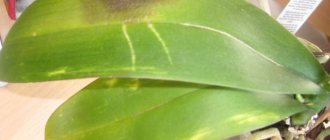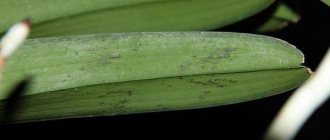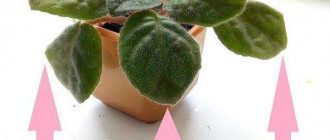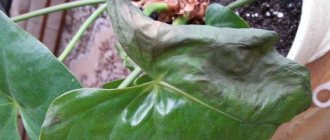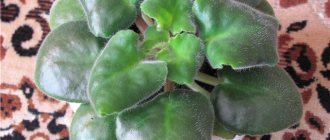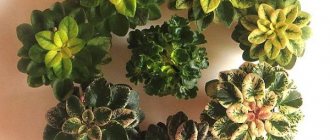The appearance of dark or light spots on violet leaves often indicates a violation of the technique of caring for a home flower. Draft, lack of required replanting, excessive or insufficient watering, large amounts of sunlight - all this can cause stains. What to do? It is necessary to normalize the watering schedule (not when it is convenient, but when the soil is dry), change the soil and check whether the plant has enough light. If the reason is not due to care, then it is possible that the violet has become a victim of an attack by pests or fungal/infectious diseases.
Causes of stains
There are three main causes of spots on violet leaves, namely:
- parasite attack;
- improper flower care;
- disease.
The spots can be brown (as if rusty), and dark purple, yellow and white. Regular examination of the condition of the flower will help prevent the development of the disease at an early stage, since violet is a capricious flower, and treatment takes a lot of time.
Preventive measures
To significantly reduce the risk of damage to indoor violets from fungal diseases and pests is to follow fairly simple rules of agricultural technology and carry out preventive measures.
According to experienced violet growers, the greatest danger comes from violets (rosettes) purchased at street markets or from unscrupulous sellers. Without a month's quarantine, they should not be exhibited together with other house plants.
From the first day of purchase, appropriate care and growing conditions should be established. Strictly monitor the watering sequence, apply fertilizers in a timely and correct manner.
The best disease prevention is proper care.
Prevention:
- quarantine;
- sterilization of container and soil;
- quality of the plant upon purchase;
- compliance with the rules of agricultural technology.
Parasite attack: what to do?
Violets are often attacked by parasites, due to which not only the leaf cover suffers, but also the root system, as a result of which the flower dies.
The flower is affected by the following insect pests:
| Pest name | Manifestation | What to do? |
| Cyclamen mite | The first sign of damage to a flower is that new leaves stop appearing. The violet stops growing and developing, which is why the flowering process stops. The central leaves curl, and then brown spots appear on them. | You need to fight the tick with chemicals, such as Fitoverm or any other insecticide. |
| Nematode | Insects attack the root system of the violet and its vessels. Pests feed on plant sap, releasing toxins while eating, which destroy the tissue nutrition system with useful substances. The flower stops developing. The leaves are deformed. Babies grow on the plant, and nodes and thickenings (bubble-like) appear on the roots. | There are no treatments. The infected flower must be destroyed along with the soil, and the pot must be disinfected. |
| Aphid | Parasites multiply on the back of the violet leaf, covering the surface with sticky secretions. | The violet needs to be treated with a soap solution, tobacco dust or chemicals such as Antitlin and Fitoverm. |
| Thrips | These are small parasites that can be seen with the naked eye on the back of a violet leaf. Light yellow or gray spots appear on the front side of the leaf that the parasite eats. Thrips feed on plant sap and multiply quickly. The flower weakens, the buds begin to wither and die. Parasites easily move to neighboring plants. | The infected flower along with the soil must be treated with Aktara. |
| Mealybug | Appears in the form of white plates on the leaves and petioles of violets. Light lumps form on the ground, which are where pests accumulate. | Infected leaves and petioles should be removed, and the healthy part of the flower should be treated with Mospilan or Regen. |
| Sciarides | Pests look like small black flies. They feed on the sap of the plant, which causes the leaves to weaken, become deformed and die. In addition, sciarids can destroy the root system of violets. | To cure an infected flower, it is necessary to properly care for the violet and use systemic insecticides. |
Do not spare the affected leaves or violet buds and cut them off partially. The faster they are removed, the sooner the flower will recover.
Diseases of violet leaves
The violet flower is susceptible to diseases such as rot and fusarium, as well as powdery mildew, late blight and viruses. All these diseases at different stages affect the color and condition of the leaves.
The cause of the development of diseases can be:
- Mineral deficiencies, such as lack of phosphorus or potassium, can contribute to the appearance of fungus.
- Unsuitable soil. There are often cases of diseases in flowers grown not in mixed soil purchased at a flower shop, but in garden soil or soil collected from the forest.
- High humidity.
- Lack of sunlight.
- Excess nitrogen (leads to the appearance of fungus).
- Failure to comply with the recommended temperature conditions.
Another reason for the development of diseases may be the water used for irrigation (too cold or hot, drawn from the tap, etc.).
Rot
In violets, rot on leaves and roots can appear after:
- cutting off babies;
- excess moisture;
- flower separation;
- parasite attacks;
- cutting off the top of the rosette for the purpose of replanting.
Symptoms of the disease:
- brown spots appear on the leaves;
- the leaves become soft and limp in structure;
- the petioles begin to die.
If the spots have reached a large size and there are many of them, then treatment should begin by removing the damaged leaves and shoots of the violet.
The types of rot are described in table form:
| Name of the disease | Manifestation | Treatment |
| Gray rot | On the front side of the leaf, fluffy spots of light or dark gray color appear, which weaken the violet and gradually cover the entire green part of the flower. | Affected leaves must be removed so that nothing gets into the pot. To avoid reappearance, you need to stop spraying the leaves and not be overzealous when watering. |
| Root rot | Pale yellow and light brown formations appear on the foliage. The leaves begin to weaken and the roots of the flower soften. | The number of waterings should be reduced and preventive measures should be applied, namely, root treatment, for example, with Fitosporin. It is also advisable to replant the plant in light soil that does not retain moisture. |
| Brown rot | The stem of the flower acquires a brownish-brown tint, after which it becomes weak and thin. The soil under the leaves is covered with light threads. | Treatment must be carried out immediately after symptoms are detected, as rot is quickly transmitted to neighboring plants. The violet stem should be treated with any fungicide, and the soil with Fitosporin. |
In addition, after detecting symptoms of any type of rot, it is recommended to set the infected flower aside from other indoor plants.
Powdery mildew
A symptom that violet leaves have been affected by powdery mildew is the covering of the green cover with a light coating of white or gray (see photo below). If you walk over the surface of the leaf with a rag or your hands, the plaque can be removed, and underneath it will be noticeable that the leaf is weakened. Over time, the disease will gradually affect the flower buds, and the leaves will turn dark and fall off. Infected buds will never bloom.
What to do about a fungal infection? Treatment proceeds as follows:
- If the disease is just developing, then the leaves need to be wiped with a solution of potassium permanganate (1/4 g of potassium permanganate per 1 liter of liquid).
- At more advanced stages of the disease, all damaged leaves and buds must be cut off with sterile scissors and thrown away. Be sure to wash scissors and hands after the procedure.
- The diseased flower should be set aside from other indoor plants until all symptoms of powdery mildew have been eliminated.
The following chemicals can be used to treat flower leaves:
- "Epin";
- "Skor";
- "Zircon";
- copper sulfate;
- "Topaz".
The drugs should be diluted and used strictly according to the instructions written on the packaging.
Fusarium
A disease such as fusarium develops from the root system of the flower, and then smoothly passes to the leaves. When the roots begin to rot, the infection rises higher through the vessels of the violet to the stems, then the petioles, and lastly to the leaves. First, the green cover becomes covered with dark spots, rusty in color, and then the entire leaf becomes brown and weak, as a result of which it fades.
The disease progresses under the following conditions:
- air temperature below +16 degrees;
- insufficient feeding;
- in the period after flowering, when the violet is weakened.
There is no way to treat the flower; it must be completely destroyed along with the soil. The pot can be reused, but only after treating it with a disinfectant, for example, any fungicide.
To prevent the development of the disease, it is necessary to follow the watering schedule and treat the flower with Fitosporin once a month.
Viruses
The reasons for changes in the appearance of the flower, namely the leaves, the base of the stem, and the slow development of buds, can be viruses (bronzing and spotting).
Typically, viral diseases spread after the plant has been attacked by parasites. The spot virus manifests itself in the fact that the leaves are deformed and brown spots appear on them.
There are no treatments; the only thing that can be done is to completely destroy the flower along with the soil.
Late blight
If dry gray-brown spots appear on the leaves, this is the first sign that the violet has been affected by late blight. The disease progresses quickly, so after a few weeks the main part of the leaves can be infected, after which the entire rosette withers.
Only healthy leaves or the top of the rosette can be saved. It needs to be urgently cut off, then treated with a fungicide, and then transplanted into a new vessel.
The infected part of the flower must be destroyed, and the pot and all neighboring plants must be treated.
How to treat?
If all natural factors are in order (lighting, substrate, humidity, temperature), and signs of the disease are present, it is important to start fighting the fungus as quickly as possible. A sick violet must be isolated from healthy plants.
There are folk recipes for processing violets.
- Regular iodine, which is always in your home medicine cabinet, will help. Prepare a solution, take 3 milliliters of iodine per liter of water. Spray the plant with the resulting medicine.
- To remove powdery mildew from leaves, you need to do additional processing. For a liter of water you need to take 1 milliliter of liquid soap and a level teaspoon of table soda. Treat the surface of the affected leaves with this product.
- A solution made from whey in a ratio of 1 to 10 has proven itself to be beneficial.
It is necessary to spray diseased flowers three times a day every three days.
You can use drugs from the fungicide group:
- "Bayleton";
- “Topaz”, which, unlike all the substances presented, is safe for the health of people and pets;
- "Fundazol".
Toxic substances are used strictly following the instructions, always observing personal safety measures (gloves, respirator, goggles).
Before processing, flowers need to be prepared:
- remove all affected leaves and flowers;
- let the substrate dry, reducing watering for a while;
- place the pot of violets in a more illuminated place;
- adjust the temperature (air temperature not lower than 18 degrees);
- remove the top layer of the substrate, replacing it with a new one.
Improper care
Due to improper care of the violet, brown, dark purple or light spots may appear on its foliage.
The reasons for the formation of stains are as follows:
- the flower is located in a place where there is a draft;
- a mandatory transfer was missed;
- watering recommendations are violated (not enough or too much liquid);
- the lighting is incorrectly selected (direct rays instead of diffused ones, not enough light, etc.).
Failure to comply with care requirements can lead to the death of the plant. After spots of any color appear on the leaves, it is necessary to establish the cause of their appearance and change the conditions for growing the flower.
Lighting
Violet needs a lot of light, but cannot grow in direct sunlight. If the flower is placed on the south side of the room, where light constantly falls on it, then burns may appear on the green part of the plant - light yellow spots, usually round in shape, which gradually darken to brown. Burns may cause a small hole to appear in the center of the leaf.
Note: burns on the leaves appear on the side where the window is located.
Damaged leaves should be cut off and the flower moved to another place where diffused light will fall on it.
No transfer
The appearance of brown or brown spots on the (lower) leaves of the violet indicates that the soil has become alkaline, which means the flower needs to be replanted.
The lack of new soil can cause the death of plants, as the alkaline soil will gradually destroy the flower.
Watering
You cannot water the violet with cold water, as this may cause the leaves to become covered with white spots. In addition, if you water the plant in the first half of the day, it will get burned due to the sun hitting the wet surface of the leaf.
The procedure is recommended to be carried out in the evening between 17-19 hours to reduce the risk of burns. For irrigation, use water at room temperature.
Draft
A manifestation of the fact that drafts negatively affect the condition of the violet are spots of gray, brownish or white color that appear on the foliage. Violet is a heat-loving flower, so even in the summer you should not keep the pot near an open window.
For the flower to return to normal, it is enough to move the pot to another place - and the plant will recover on its own. However, damaged foliage should be removed.
What to do if dark or light spots appear on violet leaves? It is necessary to reconsider the care of the flower and make sure that it is in a suitable place without circulating drafts and direct rays of the sun. In addition, the cause of yellow, brown or white spots can be pests or diseases. The likelihood of saving your violet will increase if you recognize the appearance of parasites or viruses in the early stages. To do this, it is enough to carefully inspect the plants once every few weeks.
Prevention
Disease is always easier to prevent, so when growing Saintpaulia it is worth considering some recommendations:
- comply with all conditions for the normal development and growth of the flower;
- ensure that the water does not stagnate after watering;
- from time to time treat flower pots and the places where they stand with “Topaz”;
- saturate the soil with phosphorus and potassium;
- Keep new flowers separate from other plants at first to make sure they are not infected.
You can find out more about problems with violets and how to get rid of them.
The exquisite flowering of indoor violets brings true pleasure to lovers of home floriculture. The variety of species, shapes and colors is increasingly attracting those who want to grow these delicate creatures.
But in order for Saintpaulia to please the owner and bring complete satisfaction with harmonious flowering, and not suffer from all sorts of diseases, it needs appropriate care and knowledge of agricultural cultivation techniques.
If you do not take any action or carry it out incorrectly, the plant may simply die in a short time.
